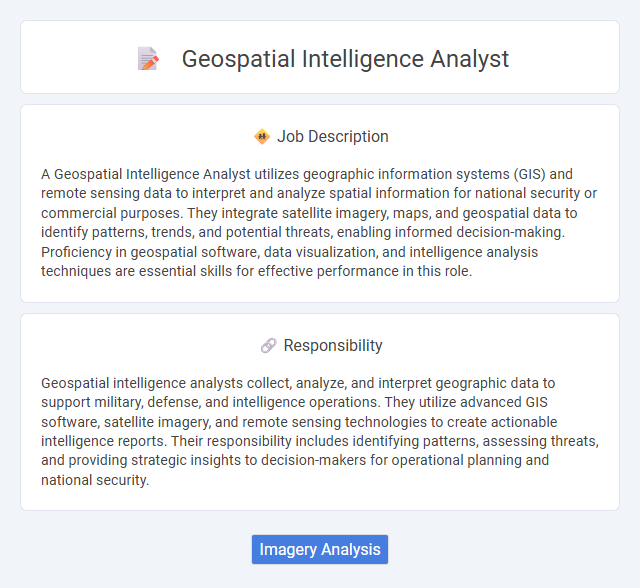
A Geospatial Intelligence Analyst utilizes geographic information systems (GIS) and remote sensing data to interpret and analyze spatial information for national security or commercial purposes. They integrate satellite imagery, maps, and geospatial data to identify patterns, trends, and potential threats, enabling informed decision-making. Proficiency in geospatial software, data visualization, and intelligence analysis techniques are essential skills for effective performance in this role.
Individuals who possess strong analytical skills, attention to detail, and interest in geography and data interpretation are likely suitable for a Geospatial Intelligence Analyst role. Those who thrive under pressure, have excellent problem-solving abilities, and can work with advanced geospatial technologies will probably find success in this job. People lacking patience for detailed data analysis or who prefer less technical tasks may find this role challenging.
Qualification
A Geospatial Intelligence Analyst requires expertise in Geographic Information Systems (GIS), remote sensing, and spatial analysis techniques. Proficiency in software tools such as ArcGIS, ENVI, and Google Earth Engine is essential, along with strong analytical skills to interpret satellite imagery and geospatial data. A background in geography, computer science, or a related field combined with security clearance often enhances job qualification and effectiveness.
Responsibility
Geospatial intelligence analysts collect, analyze, and interpret geographic data to support military, defense, and intelligence operations. They utilize advanced GIS software, satellite imagery, and remote sensing technologies to create actionable intelligence reports. Their responsibility includes identifying patterns, assessing threats, and providing strategic insights to decision-makers for operational planning and national security.
Benefit
A Geospatial intelligence analyst likely enhances decision-making accuracy by interpreting spatial data and imagery, improving operational efficiency in various sectors. The role potentially offers career growth opportunities due to increasing demand for advanced geospatial technologies and data analysis skills. Analysts may also benefit from competitive salaries and the chance to contribute to national security or disaster response efforts.
Challenge
Geospatial intelligence analysts likely face the challenge of interpreting vast amounts of complex spatial data to identify patterns and trends critical to national security. The probability of encountering rapidly evolving technologies requires continuous learning and adaptation to deliver accurate and timely intelligence. Managing the pressure of high-stakes decision-making in dynamic environments may also demand exceptional analytical and problem-solving skills.
Career Advancement
Geospatial intelligence analysts leverage geographic data and satellite imagery to support national security and military operations, with career advancement opportunities fueled by expertise in GIS technology, remote sensing, and data analytics. Progression typically involves moving from entry-level analyst roles to senior analyst, supervisory positions, or specialized fields such as cyber intelligence or geospatial data science. Continuous professional development, certifications like GISP or PMBOK, and experience in advanced geospatial tools significantly enhance career growth prospects.
Key Terms
Imagery Analysis
Geospatial intelligence analysts specializing in imagery analysis utilize satellite and aerial images to identify patterns, monitor changes, and provide actionable intelligence for military, environmental, or security applications. Expertise in remote sensing technologies, image processing software, and geographic information systems (GIS) is crucial for accurate interpretation and mapping of geospatial data. Their work supports strategic decision-making by delivering detailed visual insights that enhance situational awareness and threat assessment.
 kuljobs.com
kuljobs.com